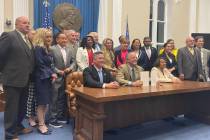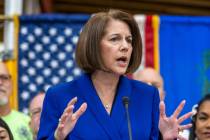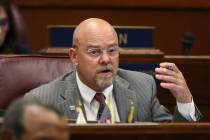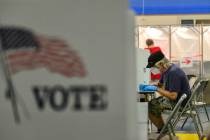With population and power, South could finally rise
I’ve often said the difference between Northern and Southern Nevada is that people up north wake up every day wondering how Las Vegas is planning to do them harm, and people in Las Vegas wake up every morning and don’t give the north a second thought.
And recent census figures may serve to reinforce that notion.
It turns out Clark County is now home to 72 percent of Nevadans, dwarfing Washoe County at 15 percent and rural Nevada with 13 percent.
Politically speaking, if Clark County’s politicians were to band together and flex their regional muscle, there’s nothing they couldn’t secure for the once-booming southern end of the state.
The funding disparity between UNR and UNLV? Erased. The rural water pipeline proposed by the Southern Nevada Water Authority as the cure for future droughts? A done deal. More road-building dollars to relieve congested Southern Nevada freeways and surface streets? Easily acquired. And more funds for struggling entities such as University Medical Center, which serves Arizona, parts of California’s San Bernardino County and Southern Nevada as the region’s only Level 1 trauma center? No problem.
And why not? For far too long, the population-rich south has subsidized the north, for two main reasons: The unity and political power of the Northern Nevada legislative delegation, and the disunity of Southern Nevada’s politicians. But that may be changing.
In the north, people tend to organize around regional lines. With some exceptions, Republicans and Democrats come together when it tends to benefit the region, even though they’re members of different political parties. That’s why you’ll see typically small-government Republicans encouraging an expansion of the Legislature as part of this session’s redistricting process (more on that in a second).
In the south, by contrast, elected officials tend to organize around political lines, with traditional Republican-Democrat fights. That’s why Republicans can be found fighting taxes that would benefit Southern Nevada by funding much-needed projects.
The traditional system may be breaking down. Nobody has done more for Northern Nevada than former state Sen. Bill Raggio, who cleverly outmaneuvered the more populous Southern Nevada delegation session after session, keeping money and power flowing in portions of the state that simply shouldn’t have received as much as they did.
But — for expressly political reasons — Raggio was dethroned from his position as leader of the Senate’s Republican minority last year. His eminently reasonable rejection of Sharron Angle’s U.S. Senate candidacy and endorsement of Harry Reid did him in, despite his long history of service to his state and, more specifically, his region.
In order to take advantage of its political power, lawmakers from Southern Nevada need to do two things: First, they must prevent rural and Northern Nevada from expanding the Legislature. Because districts must be roughly equal in population, Las Vegas’ gain is Northern Nevada’s loss. If the Legislature remains at 63 members, districts in Northern and rural Nevada will grow while districts in Southern Nevada will shrink.
Second, Southern Nevada’s delegation must start sticking together on a regional basis the way Northerners do. They need to vote — as a bloc — to ensure the lion’s share of state resources go to where the lion’s share of the population lives. (The cries of protest from otherwise anti-government rural Republicans will ring out, without a hint of irony, too.) But if they truly want to take advantage of their strength in numbers, Southern Nevada’s politicians need to emulate the rural leaders of the past and put the good of their constituents first.
Maybe it’s finally time for Las Vegas to give the rest of the state a second thought, after all.
Steve Sebelius is a Review-Journal political columnist and author of the blog SlashPolitics.com. Follow him on Twitter at www.Twitter.com/SteveSebelius or reach him at 387-5276 or at SSebelius@ reviewjournal.com.













